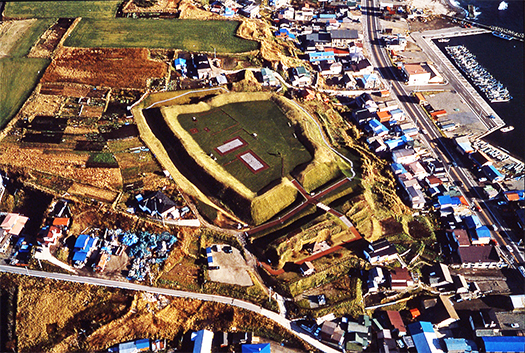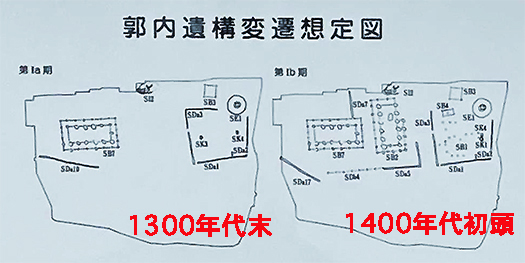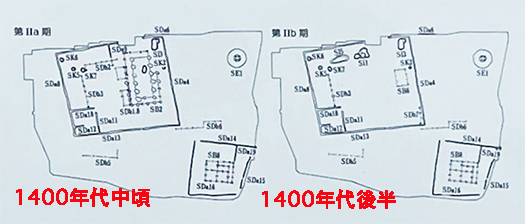


きのうなにげに函館市内に残る中世城郭「志苔館」遺跡参観の記事を書いたら、けっこうな反響があって驚いています。建築と関連しての歴史探訪、そこそこ多くのみなさんの関心を惹くのだなぁとあらためて気付かされた次第。「道南十二館」についてもっと書けという叱咤激励もいただきましたが、わたしのライフワークがいま佳境に入りつつあって、その上、また上乗せで北海道島の明治以前に突っ込んでいく体勢はちょっと難しい。
それなりに記事構成したいと思いますので、ご容赦を。
あ、ライフワークの方は進展がありましたらまたご案内・報告させていただきます。それと、NHK「デビュー」についても多くの反響をいただき、別件で連絡した方からもいきなり「見たよ」みたいな反応をいただきました(笑)。なんと旧知の建築研究者の方からはNHK北海道のWEB版で別の動画もアップされているとお知らせいただきました。せっかくですのでURLを案内します。
<函館でのNHK出演。これですね。WEBニュースにも載っていました。
https://www3.nhk.or.jp/news/html/20240424/k10014431761000.html >
おっと、お知らせなどを書いていたらそれだけでけっこうな字数。
テーマの「志苔館」遺跡ですが、函館市の発掘調査記録や、民間の篤志のみなさんの「深掘り」記録がどんどん出てきます。どうもこの「志苔館」の館主である小林氏は、南北朝動乱期にこの地に逃れてきた武家一族ということは既報ですが、たぶんその年代は1300年代の末頃。
で、函館市の発掘調査による居館建築の柱穴痕跡も、年代的に合致するようです。2枚目と3枚目の図版でおわかりのように1300年代末から1400年代後半、約100年間ほどの「建築の痕跡」が解明されている。
〜出典/函館市HP https://www.city.hakodate.hokkaido.jp/docs/2018032900043/
<三木がデータを編集加工しました。>〜
明治期まで北海道島の本格的活用、国土化は十分に進展しなかったし、とくに日本人の基盤である農業振興、農地開発、さらには寒冷地適合の品種改良での米作の進展などは行われなかった。そういう意味では本格的な「歴史」とは言い切れないけれど、日本社会・アイヌ社会との「交易」は歴史年代を通じてかなり古く、それこそ阿倍比羅夫の「後方羊蹄〜シリベシ」政庁記録くらいまで遡れる。基本は交易が支えていた。
で、この南朝方の武家・小林氏はこの地で産する「コンブ」を主要な交易利権として生き延び続けていたことが推測できる。〜南北朝時代末期から室町時代前期の成立とされる『庭訓往来(ていきんおうらい)』には全国の名産品が紹介され、このなかに蝦夷地の宇賀の昆布と夷の鮭が掲載されている。宇賀の昆布は津軽海峡に面した志濃里(志海苔・志苔)およびその周辺で生産された昆布を指すもので、この昆布だけが真昆布といわれた。室町時代には多くの北陸の商船が宇賀昆布の取引のために訪れており、日本海を交易ルートとして若狭国小浜に搬ばれて加工され、若狭昆布として京都・大阪方面に流通している。この蝦夷地の特産品の出荷拠点が志濃里(志苔)であった。志苔館はこれら宇賀昆布の交易の主体と推測可能。
こういう経済基盤があれば、交易立国は可能だっただろう。武家としてその後の戦乱期にこの館の動員兵力は300人だったとされ、コシャマインの戦いでは総数1万と言われたアイヌ軍に陥落させられている。やはり交易利権だけでは人口増加は難しかったのだろう。
<この項、もうちょっと続きます>
English version⬇
Hakodate “Shikokukan” Kelp Economy in the Nanbokucho and Muromachi Periods
A report on the response to my recent blog postings, and a search for the basis for the establishment of Shikokukan. I dig deeper to find out if it was a “kelp” concession. …
Yesterday I casually wrote an article about my visit to the ruins of Shikokukan, a medieval castle in Hakodate City, and was surprised by the response I received. I was surprised by the response to my article about visiting the ruins of “Shikokan,” a medieval castle in Hakodate. I received a pep talk from a friend who urged me to write more about “Donan Jyunikan,” but my life’s work is now entering its climax, and it is a bit difficult to go into the pre-Meiji period of Hokkaido Island on top of my life’s work.
I will try to compose my articles accordingly, so please forgive me.
I will keep you posted on the progress of my life’s work. Also, I received a lot of feedback about NHK’s “Debut,” and even a person I contacted about a different matter suddenly responded, “I saw it” (laughs). One of our old acquaintances, an architecture researcher, informed us that another video was also uploaded on NHK Hokkaido’s website. Since I am here, I will show you the URL.
The full-scale utilization and nationalization of Hokkaido Island did not fully develop until the Meiji period (1868-1912), and in particular, the promotion of agriculture, farmland development, and the development of rice cultivation with improved varieties adapted to cold regions, which are the foundation of the Japanese people, did not take place. In this sense, it cannot be said to be a full-fledged “history,” but “trade” between Japanese and Ainu society is quite old throughout history, dating back as far as Abenohirau’s “Backward Essentials – Siribeshi” government records. Basically, trade supported them.
The Kobayashi clan, a warrior family of the Nanbokucho period, had been surviving on the kelp produced in the area as their main trading interest. 〜The “Teikin Ourai,” a book that is said to have been written between the end of the Nanbokucho period and the beginning of the Muromachi period (1336-1573), introduces famous products from all over Japan, and among them are kelp from Uga in the Ezo region and salmon from the barbarian region. Uga kelp refers to kelp produced in and around Shinosato (Shikori or Shiko), which faces the Tsugaru Straits, and only this kelp was considered to be true kelp. During the Muromachi period (1333-1573), many merchant ships from the Hokuriku region came to trade in Uga kelp, which was brought to Obama in Wakasa Province via the Sea of Japan trade route, processed, and distributed as Wakasa kelp in the Kyoto and Osaka areas. Shikori (Shikoke) was the shipping center for this specialty of the Ezo region. It can be assumed that Shikokan was the main trading center for these Uga kelp products.
With such an economic base, it would have been possible to establish a trading nation. As a warrior family, the Shikokan is said to have mobilized a force of 300 men during the period of warfare that followed, and at the Battle of Koshamain, it was defeated by an Ainu army said to number 10,000 men. It was probably difficult to increase the population with trading interests alone.
<This section will continue in a little more detail.
Posted on 4月 27th, 2024 by 三木 奎吾
Filed under: 日本社会・文化研究, 歴史探訪







コメントを投稿
「※誹謗中傷や、悪意のある書き込み、営利目的などのコメントを防ぐために、投稿された全てのコメントは一時的に保留されますのでご了承ください。」
You must be logged in to post a comment.